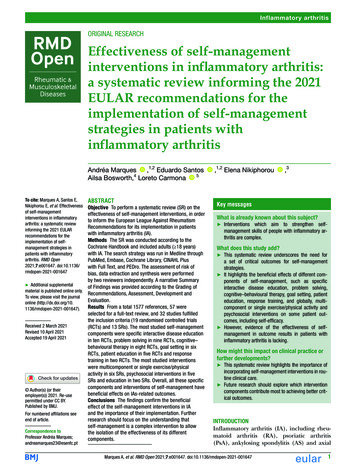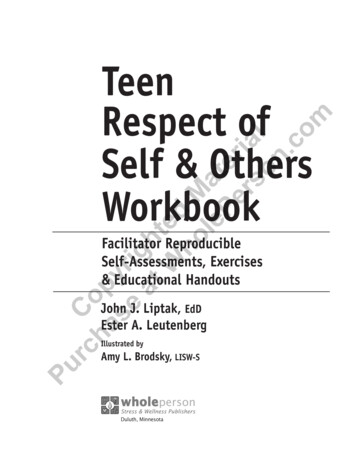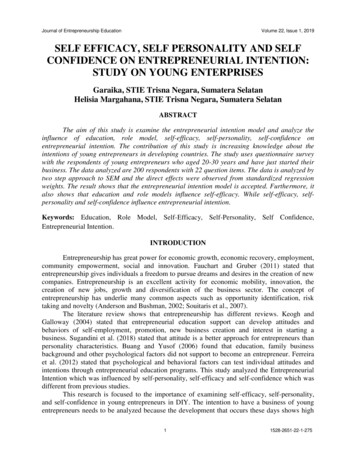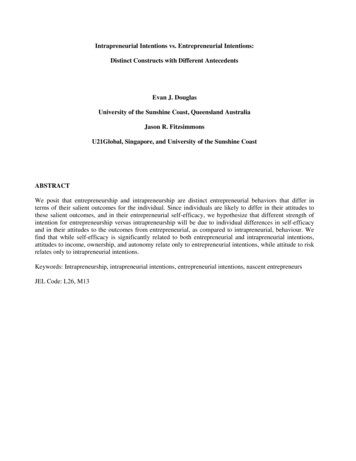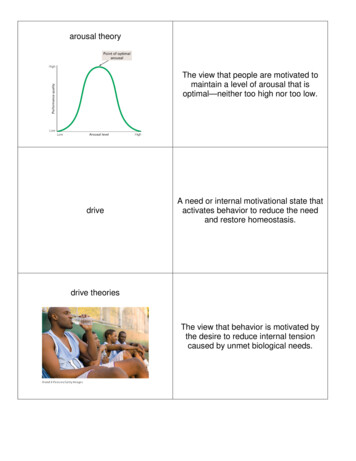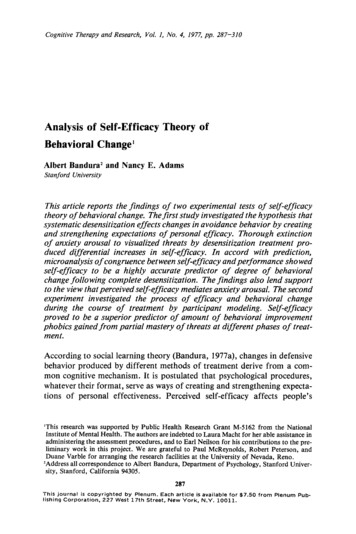
Transcription
Cognitive Therapy and Research, VoL 1, No. 4, 1977, pp. 287-310Analysis of Self-Efficacy Theory ofBehavioral Change'Albert Bandura2 and Nancy E. AdamsStanford UniversityThis article reports the findings o f two experimental tests o f self-efficacytheory o f behavioral change. The first study investigated the hypothesis thatsystematic desensitization effects changes in avoidance behavior by creatingand strengthening expectations o f personal efficacy. Thorough extinctionof anxiety arousal to visualized threats by desensitization treatment produced differential increases in self-efficacy. In accord with prediction,microanalysis o f congruence between self-efficacy and performance showedself-efficacy to be a highly accurate predictor o f degree o f behavioralchange following complete desensitization. The findings also lend supportto the view that pereeived self-efficacy mediates anxiety arousal. The secondexperiment investigated the process o f efficacy and behavioral changeduring the course o f treatment by participant modeling. Self-efficacyproved to be a superior predictor o f amount o f behavioral improvementphobics gained from partial mastery o f threats at different phases o f treatment.According to social learning theory (Bandura, 1977a), changes in defensivebehavior produced by different methods of treatment derive from a common cognitive mechanism. It is postulated that psychological procedures,whatever their format, serve as ways of creating and strengthening expectations of personal effectiveness. Perceived self-efficacy affects people's'This research was supported by Public Health Research Grant M-5162 from the NationalInstitute of Mental Health. The authors are indebted to Laura Macht for her able assistance inadministering the assessment procedures, and to Earl Neilson for his contributions to the preliminary work in this project. We are grateful to Patti McReynolds, Robert Peterson, andDuane Varble for arranging the research facilities at the University of Nevada, Rend.2Address all correspondence to Albert Bandura, Department of Psychology, Stanford University, Stanford, California 94305.287This journal is copyrighted by Plenum. Each a r t i c l e is a v a i l a b l e f o r 7.50 f r o m Plenum Publishing Corporation, 2 2 7 West 17th Street, New Y o r k , N.Y. 10011.
288Bandura and Adamschoice of activities and behavioral settings, how much effort they expend,and how long they will persist in the face of obstacles and aversive experiences. The stronger the perceived self-efficacy, the more active the copingefforts. Those who persist in subjectively threatening activities willeventually eliminate their inhibitions through corrective experience, whereas those who avoid what they fear, or who cease their coping efforts prematurely, will retain their self-debilitating expectations and defensivebehavior.In this social learning analysis, expectations of personal efficacy stemfrom four main sources of information. Performance accomplishmentsprovide the most influential efficacy information because it is based on personal mastery experiences. The other sources of efficacy informationinclude the vicarious experiences of observing others succeed through theirefforts, verbal persuasion that one possesses the capabilities to cope successfully, and states of physiological arousal from which people judge theirlevel of anxiety and vulnerability to stress.Empirical tests of this theory (Bandura, Adams, & Beyer, 1977), confirm that different treatment approaches alter expectations of personal efficacy, and the more dependable the source of efficacy information, thegreater are the changes in self-efficacy. Thus, treatments based on performance accomplishments through the aid of participant modelingproduce higher, stronger, and more generalized expectations of personalefficacy than do vicarious experiences alone. Results of a microanalysis ofthe congruence between self-efficacy and performance reveal that behavioral changes correspond closely to level of self-efficacy whether instatedenactively or vicariously.As a further test of the generality of this theory, an experiment wasconducted of efficacy expectations instated by systematic desensitization,which is aimed at eliminating emotional arousal. Social learning theory andthe dual-process theory of anxiety, on which the desensitization approach isbased, posit different explanatory mechanisms for the changes produced bythis mode of treatment.The standard desensitization approach is based on the assumptionthat anxiety activates defensive behavior (Wolpe, 1974). According to thisview, association of neutral events with aversive stimulation creates ananxiety drive that motivates defensive behavior. The defensive behavior, inturn, is reinforced by reducing the anxiety aroused by conditioned aversivestimuli. Hence, to eliminate defensive responding it is considered necessaryto eradicate its underlying anxiety. Treatment strategies are therefore keyedto reduction of emotional arousal. Aversive stimuli are presented at graduated levels in conjunction with relaxation until anxiety reactions to thethreats are eliminated.
Self-Efficacy Theory289Although desensitization produces behavioral changes, the principalassumption that defensive behavior is controlled by anxiety arousal is disputed by several lines of evidence (Bandura, 1977b; Bolles, 1972; Herrnstein, 1969; Rescorla & Solomon, 1967). Autonomic arousal, which constitutes the principal index of anxiety, is not necessary for defensive learning.Maintenance of avoidance behavior is even less dependent upon autonomicfeedback. Social learning theory regards anxiety and defensive behavior ascoeffects rather than as causally linked (Bandura, 1977b). Aversive experiences, of either a personal or a vicarious sort, create expectations of injurious consequences that can activate both fear and defensive behavior. Beingcoeffects, there is no fixed relationship between autonomic arousal andactions.Dual-process theory predicts that thorough extinction of anxietyshould eliminate avoidance behavior. In the desensitization treatment, however, anxiety reactions are typically eliminated to visualized representations of feared situations. One would expect some transfer loss of extinctioneffects from symbolic to real-life threats, as is indeed the case (Agras, 1967;Barlow, Leitenberg, Agras, & Wincze, 1969). It is not uncommon forpeople to perform less than they have been desensitized to in imagery.Therefore, extinction of anxiety to visualized threats might be expected toproduce substantial, though less than complete, reductions in avoidance behavior. However, since anxiety arousal to visualized threats is completelyeliminated in all subjects, dual-process theory provides no basis for predicting the substantial variability in behavior commonly displayed by subjectswho have all been equally desensitized.Stressful situations generally elicit emotional arousal that, dependingon the circumstances, might have informative value concerning personalcompetency. Therefore, emotional arousal is a constituent source of information that can affect perceived self-efficacy in coping with stressful situations (Bandura, 1977a). Because high levels of arousal usually debilitateperformance, individuals are more likely to expect to function effectivelywhen they are not beset by aversive arousal than if they are tense and viscerally agitated. Treatment approaches that focus on physiological arousal asthe major factor requiring modification further reinforce the expectationthat anxiety arousal governs behavioral functioning. Clients are taught howto manage their physiological arousal, they learn to discriminate small variations in their level of arousal, and most of the treatment strategies are designed to eradicate physiological arousal to subjective threats. By the structuring explanations and therapeutic practices, arousal is thus given considerable salience.From the perspective of social learning theory, reducing physiologicalarousal improves performance by raising efficacy expectations rather than
290Bandura and Adamsby eliminating a drive that instigates the defensive behavior. This cognitivemediating mechanism of change places greater emphasis on the informativethan on the automatic energizing function of physiological arousal. Mostarousal is activated by thought, and cognitive appraisal of arousal states toa large extent determines the level and direction of motivational inducements to action (Bandura, 1977b; Weiner, 1972). Because arousal is onlyone of several sources of efficacy information, and not necessarily the mostdependable one, extinguishing anxiety arousal is rarely a sufficient condition for eliminating avoidance behavior.To test the theory that desensitization changes behavior through itsintervening effects on efficacy expectations, severe phobics were administered the standard desensitization treatment until their anxiety reactionswere completely extinguished to imaginal representations of the mostaversive scenes. Their approach behavior and efficacy expectations weremeasured before and after completion of desensitization treatment. Theperceived self-efficacy of phobics reflects the direct and mediated experiences they have had with what they fear, as well as appraisals of their physiological arousal to the threats. Because subjects have met with differenttypes and amounts of efficacy-generating experiences, it was hypothesizedthat eliminating emotional arousal alone would enhance self-efficacy butthe levels attained would vary. It was further predicted that the higher andstronger the efficacy expectations instated by the desensitization treatment,the greater would be the reductions in avoidance behavior.METHODSubjectsSubjects whose social, recreational, and vocational activities were adversely affected by chronic snake phobias were recruited through advertisements placed in a newspaper serving a metropolitan area and its suburbancommunities. All but one of the subjects who participated in the desensitization study were females. They ranged in age from 19 to 57 years with amean age of 31 years.Pretreatment MeasuresA multifaceted assessment procedure was used to provide the data required for a microanalysis of changes in expectations of personal effectiveness and avoidance behavior.
Self-Efficacy Theory291Behavioral Avoidance. The test of avoidance behavior consisted of aseries of 29 performance tasks requiring increasingly more threateninginteractions with a red-tailed boa constrictor. The hierarchical set of tasksrequired subjects to approach a glass cage containing the snake, to lookdown at it, to touch and hold the snake with gloved and bare hands, to let itloose in the room and return it to the cage, to hold it within 12 cm of theirfaces, and finally to tolerate the snake crawling in their laps while they heldtheir hands passively at their sides.A female tester administered all the assessment procedures. Prior tomeasuring phobic behavior, subjects were given factual information aboutthe characteristics and habits of snakes to eliminate moderately fearful subjects who might be emboldened by factual information alone. Those whocould not enter the room containing the snake received a score of zero;subjects who did enter were asked to perform the various tasks in the gradedseries. To control for any possible influence of expressive cues from thetester, she stood behind the subject and read aloud the tasks to be performed.The avoidance score was the number of snake-interaction tasks thesubject performed successfully. Those who could lift the snake inside thecage with a gloved hand were considered insufficiently fearful and were notincluded in the experiment. To maximize the generality of the findings, allpeople who were sufficiently phobic on the behavior test were selected forstudy.FearArousalAccompanying Approach Responses. In addition to themeasurement of performance capabilities, the degree of fear aroused byeach approach response was assessed. During the behavioral test, subjectsrated orally, on a 10-interval scale, the intensity of fear they experiencedwhen each snake approach task was described to them, and again while theywere performing the corresponding behavior. These fear ratings for all theapproach tasks actually completed were averaged to provide the index offear arousal.Efficacy Expectations. In the pretest phase efficacy expectations weremeasured after the test of behavioral avoidance so that subjects would havesome understanding of what types of performances were required. Separatemeasures were obtained of the magnitude, strength, and generality of expectations.Subjects were provided with the list of performance tasks included inthe behavioral test and instructed to designate those they expected to perform as of then. For each task so designated, they rated the strength of theirexpectations on a 100-point probability scale, ranging in 10-unit intervals,from high uncertainty through intermediate values of certainty to completecertitude. The level of self-efficacy was the number of performance tasks
292Bandura and Adamssubjects designated they expected to perform with a probability value above10, which was the lowest point on the scale signifying virtual impossibility.Strength of self-efficacy was computed by summing the magnitude ofexpectancy scores across tasks and dividing the sum by the total number ofperformance tasks. To provide an index of the generality of self-efficacy,subjects rated the level and strength of their expectations in copingsuccessfully with an unfamiliar snake as well as with a boa constrictor similar to the one used in treatment.Efficacy expectations were measured after the behavioral pretest,prior to the posttest that was administered within a week after treatmentwas concluded, and after completing the behavioral posttest. These expectations were recorded privately and remained so during the behavior tests tominimize any motivational inducements to improve performance that couldarise had the expectations been communicated publicly to the examiner.Situational Generalization of Fear and Self-Efficacy. Situational generalization of the effects of desensitization was assessed in terms of subjects' anticipatory fear of snake encounters under different natural conditions and their self-efficacy in coping with them.Fear of snake encounters in natural situations was measured on sixscales portraying diverse encounters with snakes, including visiting a reptileexhibit, watching a film on the habits of snakes, suddenly confrontingsnakes on hikes or in a garage, visiting a household containing pet snakes,and handling them. Subjects were instructed to rate each item on a 7-interval scale of fearfulness. The mean of the six ratings constituted the level ofanticipatory fear arousal over encounters with snakes.Subjects also rated the situations described above in terms of howeffectively they could cope with snakes were they to encounter them in theireverday life. The ratings were averaged to provide a score of perceived selfefficacy in dealing with snakes. In addition, they rated their self-efficacy incoping with other animals they feared and with difficult social situations.Animal and social threats were selected to provide additional measures ofgeneralization of perceived self-efficacy along a dimension of similarity tothe threat that was the focus of treatment.Systematic DesensitizationA female therapist administered to subjects individually the systematic desensitization treatment. As in the standard procedure, deep muscularrelaxation was successively paired with imaginal representations of snakescenes arranged in order of increasing aversiveness. During the first sessionsubjects received training in muscular relaxation. In addition, they wereprovided with audio cassettes and relaxation tapes for use at home to
Self-Efficacy Theory293improve their facility at inducing deep relaxation. They continued the homepractice in relaxation twice a day over 4 consecutive days.In subsequent treatment sessions, after being deeply relaxed, subjectswere instructed by the therapist to visualize the least threatening item in thehierarchy of anxiety-provoking scenes. The anxiety hierarchy contained atotal of 51 scenes ranging from relatively innocuous activities such as visualizing themselves looking at pictures and toy replicas of snakes to handlinglive snakes in ways that would be highly fear-provoking. Whenever subjectssignaled anxiety to visualization of a threatening scene it was withdrawn,relaxation was reinstated, and the same item was repeatedly presented until itceased to evoke anxiety. If relaxation remained unimpaired in the imaginedpresence of the threat, subjects' anxiety reactions to the next item in thehiearchy were extinguished. This procedure was continued throughout thegraduated series of aversive scenes until subjects' anxiety reactions to themost threatening events were completely eliminated. The average durationof the desensitization treatment, not counting the relaxation training, was 4hours, 27 minutes.Posttreatment MeasuresThe assessment procedures used in the pretreatment phase of thestudy were readministered within a week after the completion of treatment.Efficacy expectations were measured prior to, and after, the behavioralposttest to examine the reciprocal influence between expectations and performance accomplishments.To gauge the generality of changes in self-efficacy and performance,subjects' approach behavior was measured initially toward the dissimilarcorn snake and then with the red-tailed boa used in the pretest. Subjectswere tested with the dissimilar snake first to minimize possible transfereffects from performance improvements during the posttest, which wouldbe more likely to occur in dealing with a familiar threat a second time thanin coping with a new one.The same female tester who conducted the pretest administered theposttreatment measures. To control for any possible bias, she was not informed of the conditions to which subjects had been assigned.Supplementary TreatmentSubjects who failed to achieve terminal performances in the posttestafter completing the desensitization treatment were administered participant modeling until they performed all the therapeutic tasks successfully.
294Bandura and AdamsThe therapist first modeled the relevant activities and then guided the subject with response induction aids through the graded hierarchy of tasks untilthey were fully mastered. The subjects were then readministered thestandard assessment procedures.RESULTSLevel of Self-EfficacyPhobics whose anxiety arousal to visualized threats was thoroughlyextinguished emerge from the desensitization treatment with widely differing expectations of personal efficacy. The mean level of efficacy expectations and approach responses displayed by subjects at different phases ofthe experiment are presented graphically in Figure 1. Table I shows the significance of the changes achieved by subjects, as evaluated by the t test forcorrelated means.Comparison of efficacy expectations prior to treatment and followingtreatment, but before the posttest, confirms that extinction of anxietyarousal through symbolic desensitization significantly enhances selfefficacy toward similar and dissimilar threats alike (Table I). Analysis of80DESENSITIZATION --oEFFICACY EXPECTATIONS 7O BEHAVIOR o 6c.O//, o1////////////./ 4c - 30/ "/13//// /L 0. 20I0PRETESTPOSTTESTSIMILAR THREATIPRETESTIIPOSTTESTDISSIMILARTHREATFig. 1. Level of efficacy expectations and approach behavior displayed by subjects toward different threats after fear arousal to symbolic representations ofthreatening activities was eliminated through systematic desensitization.
Self-Efficacy Theory295Table I. Significance of Intragroup Changes for Each MeasureDesensitizationParticipant modelingPretestPosttestVS.VS.posttest(N 10)supplemental test(N 8)Level of efficacy expectationsTotalSimilar threatDissimilar threat4.06 a4.04 a3.83 a4.83 b5.64 b3.79 aStrength of efficacy expectationsTotalSimilar threatDissimilar threat3.99a4.06 a3.89 a3.61a3.94 a2.47 cApproach behaviorTotalSimilar threatDissimilar threat6.00 b5.5 t b4.17 a8.15 b5.19 b5.84 bFear arousalInitial approachTotalSimilar threatDissimilar threat5.16 b5.44 b5.07 b3.31 a2.80 c2.38 cTotal approachTotalSimilar threatDissimilar threat3.52 a3.05 c3.08 c4.30 a5.23 b3.20 aA n t i c i p a t o r y fear arousalTo talSimilar threatDissimilar threat4.78 b5.33 b4.17 a2.85 c2.90 c2.41 cGeneralized self-efficacySnakesOther animalsSocial5.64 b2.54 c1.463.44a1.83.36Generalized fear reduction6155 b3.75 aMeasureap .01.bp .001.Cp .05.mean approach responses yielded a similar pattern of significant increasesin approach behavior toward both threats.Although subjects expressed significantly higher self-efficacy (hg) 2.53, p . 0 5 ) and performed more approach responses (tog) 2.58,p .05) toward the similar than toward the dissimilar threat, the degree ofcorrelation between efficacy and performance was similar regardless of thenature of the threat. The higher the level of perceived self-efficacy at the
Bandura and Adams296completion of treatment, the higher was the level of approach behavior (r .75, p .01).Microanalysis of Congruence Between Self-Efficacy and PerformanceCorrelations based upon aggregate measures do not fully reveal thedegree of correspondence between self-efficacy and performance on thespecific tasks from which the aggregate measures are obtained. A subjectcan display an equivalent number of efficacy expectations and successfulperformances but they might not correspond entirely to the same tasks. Themost precise index of the relationship is provided by a microanalysis of thecongruence between self-efficacy and performance at the level of individualtasks.The microanalytic measure of congruence is obtained by recordingwhether or not subjects considered themselves capable of performing eachof the various tasks at the end of treatment and computing the percent ofaccurate correspondence between efficacy judgment and actual performance. Self-efficacy was a highly accurate predictor of approach behaviorexhibited on tasks varying in difficulty toward both threats by subjects whohad been thoroughly desensitized (84o7o congruence). The efficacy-behaviorcongruence for the similar threat (85 7o) was comparable to that for the dissimilar threat (82%).The preceding indices of congruity are based on all of the assessmenttasks, some of which subjects performed in the pretest. When the microanalysis is conducted only on the subset of tasks that subjects had never performed in the pretest assessment, the degree of congruence between perceived self-efficacy and subsequent behavior is equally high toward similar(83%) and dissimilar (81%) threats. It should be noted in passing that therelationship between efficacy judgments and performance reported in anearlier article (Bandura, 1977a) differs slightly from the correlational andcongruence indices given above because additional subjects were added tothe sample since the earlier report.Strength of Self-EfficacyIn the preceding analysis, a weak sense of self-efficacy received thesame weight as one reflecting complete certitude. However, one wouldexpect intensity and persistence of effort, and hence level of performance,to vary as a function of strength of perceived self-efficacy. The resultsreveal that desensitization enhances strength, as well as level, of efficacy expectations.
Self-Efficacy Theory297IOOi H2.0,SIMILAR THREATC.-'---O DISSIMILAR THREAT/ I//80'1.0///////600///40//-1.020-2.0 FFICACYHSIMILAR THREAT-201 X\\\\\-I.0 AR AROUSALFig. 2. Changes in strength of efficacy expectations (upper left panel),self-efficacyin coping with snake encounters in natural settings (upperright panel), fear of snake encounters in natural settings (lower leftpanel), and fear arousal accompanying interaction responses toward thetest snakes (lower right panel) displayed by subjects after receivingdesensitization (D) and participant modeling (PM) treatments.Prior to treatment, subjects expressed relatively weak p e r f o r m a n c eexpectations. The desensitization treatment, however, increased thestrength of subjects' perceived self-efficacy (Figure 2). As summarized inTable I, these differences are highly significant for both threats and for thepooled data. The stronger the performance expectations at the completiono f treatment, the higher the level of approach behavior (r .72, p .01).Because o f the high congruence between self-efficacy and performance, subjects did not alter their efficacy exPectations much after
298Bandura and Adamscompleting the behavioral posttest. They raised the strength (t 9 3.79,p .05), but not the level, of their efficacy expectations on the basis of theirachievements in the posttest.Fear Arousal Accompanying Approach ResponsesReduction in fear arousal accompanying approach responses wasevaluated by comparing the average level of fear elicited by responses thatsubjects performed before treatment with the fear levels reported in theposttest for the same subset of approach responses, and for the totalnumber of approach responses they completed successfully. Results of thestatistical analysis are shown in Table I. In accord with evidence of previousstudies (Bandura, Blanchard, & Ritter, 1969), symbolic desensitizationproduced substantial reductions in fear arousal accompanying the initialand total approach responses toward both threats, with the familiar threateliciting the weaker fearful reactions (tcg 2.29, p .05).Decreases in the level of anticipatory fear evoked in the posttest by theapproach task that subjects could not perform in pretest provides an indexof fear extinction that is unaffected by having previously performed thatparticular behavior. This measure also reveals a significant decrement infear arousal in relation to both threats (Table I).The activation of anxiety has traditionally been depicted as a processin which anxiety arousal is elicited directly either by the conditioned aversive properties of stimuli or by their symbolized representations of unconscious forces. Neither the conditioning nor the psychodynamics theories require much in the way of conscious involvement of the person in the activation process. In the social learning theory of anxiety, it is mainly the perceived lack of efficacy to manage potentially aversive aspects of the environment that makes them fearsome. People fear potential aversive eventsthat they construe as exceeding their coping capabilities, but do not findthem fearsome if they believe they can manage them.The correlational analysis lends some support to the view that perceived self-efficacy mediates anxiety arousal. The higher the subjects' levelof self-efficacy following treatment, the less was their anticipatory arousalat the prospect of performing threatening tasks they previously avoided (r - .71, p .025), and the weaker was the accompanying arousal when theysubsequently performed the various interaction tasks (r -.65, p .025).A similar pattern of relationships was obtained between strength of selfefficacy and degree of arousal. A strong sense of self-efficacy was associated with low anticipatory arousal (r -.54, p . 10) and weak anxietyarousal while performing threatening tasks (r -.60, p .05).
Self-Efficacy Theory299Situational GeneralizationThe findings on the situational generalization of treatment effects areconsistent with those obtained through direct assessment with the two different threats (Table I). Extinguishing arousal to symbolic representationsof threats reduced anticipatory fear and enhanced self-efficacy in copingwith snakes and with other animals in natural situations.Supplementary TreatmentIt will be recalled that subjects who achieved only partial improvement were administered participant modeling after the formal experimentwas completed. Only one of the subjects achieved terminal performancethrough symbolic desensitization alone. This is not surprising because mostof the subjects in the sample (80o70)were exceedingly phobic, refusing in thepretest assessment to enter the test room or even to view the snake at a safedistance. Of the remaining nine subjects, eight were available and receivedthe supplemental treatment using participant modeling.Compared to the scores obtained following desensitization treatment,participant modeling instated marked changes on all measures (Table I). Itboosted substantially the level, strength, and generality of self-efficacy; itenabled all but one subject to achieve terminal performances; it completelyextinguished anticipatory and performance fear arousal; and it enhancedself-efficacy in coping with reptiles and other animals under varying naturalconditions.In the microanalysis of efficacy-performance congruence, which is theevidence of primary theoretical interest, efficacy expectations were highlyreliable predictors of subsequent approach behavior toward similar (97o70)and dissimilar (76o7o)threats on all tasks. The corresponding congruence between self-efficacy and behavior toward similar (94o7o) and dissimilar (62o7o)threats was also high even for the restricted number of highly threateningtasks that subjects were unable to perform either in pretest or followingcompletion of desensitization treatment.MICROANALYSIS OF SELF-EFFICACY AND PERFORMANCECHANGES DURING THE COURSE OF PARTICIPANT MODELINGThe series of experiments completed to date examined the value ofefficacy expectations in predicting behavioral changes at the completion ofenactive, vicarious, and emotive modes of treatment. The present study in-
300Bandura and Adamsvestigated the process of efficacy and behavioral change d
behavior. In this social learning analysis, expectations of personal efficacy stem from four main sources of information. Performance accomplishments provide the most influential efficacy information bec
